
The Aravalli Range is a mountain range in Northern-Western India, running approximately 670 km (420 mi) in a south-west direction, starting near Delhi, passing through southern Haryana, Rajasthan, and ending in Ahmedabad Gujarat. The highest peak is Guru Shikhar on Mount Abu at 1,722 m (5,650 ft). The Aravalli Range is arguably the oldest geological feature on Earth, having its origin in the Proterozoic era.
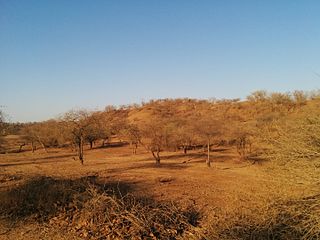
The Khathiar–Gir dry deciduous forests is a mostly arid ecoregion in northwestern India that stretches over 103,100 sq mi (267,000 km2) across Gujarat, Rajasthan and Madhya Pradesh. The dry deciduous forests in the region are dominated by teak, and thorny trees and scrub in drier areas.

Dhebar Lake is India's first and world's oldest historical and second largest artificial fresh water lake in India. It is located in the Udaipur District of Rajasthan State in western India. It has an area of 87 km2 (34 sq mi) when full, and was created at Namla Thikana (rathore-patvi) in the 17th century, when Rana Jai Singh of Udaipur built a marble dam across the Gomati River. It is about 45.0 km (28.0 mi) from the district headquarters of Udaipur. When first built, it was the largest artificial lake in the world. The surrounding Jaisamand Wildlife Sanctuary around Dhebar Lake can be reached by the state highway to Banswara from Udaipur. It is about 17.0 km (10.6 mi) from Salumbar. Jaisamand Wildlife Sanctuary protects about 162.0 square kilometres (16,200 ha), mostly teak forest, on the shores of Dhebar Lake. The lake has three islands measuring from 10 to 40 acres each. The Dhebar Lake Marble Dam is 300.0 m (984.3 ft) long and is a part of the "Heritage Monuments of India". The dam also has the Hawa Mahal Palace, winter Capital of the erstwhile Maharanas of Mewar. 1687 to 1691

Kumbhalgarh Wildlife Sanctuary is located in the Rajsamand District of Rajasthan State in western India. It surrounds the Kumbhalgarh fortress and covers an area of 610.528 km2 (236 sq mi). The sanctuary extends across the Aravalli Range, covering parts of Rajsamand, Udaipur, and Pali districts, ranging from 500 to 1,300 metres in elevation. It is part of the Khathiar-Gir dry deciduous forests ecoregion.

Jessore Sloth Bear Sanctuary is situated in the Banaskantha district formerly under Palanpur State in the Indian state of Gujarat at the Gujarat-Rajasthan border. It was declared as a sanctuary in May 1978, covering an area of about 180 square kilometres (69 sq mi), principally for protection of the sloth bear, which is now categorized as "Vulnerable A2cd+4cd;C1 ver 3.1" on the IUCN Red List. Their numbers are declining in the wild and they are threatened with extinction.

Mount Abu Wildlife Sanctuary is located in one of the oldest mountain ranges of India, the Aravalli range. It was declared a wildlife sanctuary in 1980. Te Eco sensitive zone around the sanctuary was notified on 11 Nov 2020
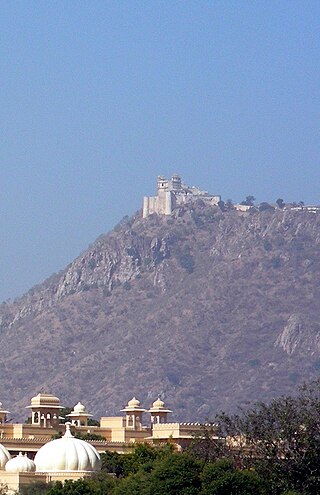
The Monsoon Palace, also known as the Sajjan Garh Palace, is a hilltop palatial residence in the city of Udaipur, Rajasthan in India, overlooking the Fateh Sagar Lake. It is named Sajjangarh after Maharana Sajjan Singh (1874–1884) of the Mewar dynasty, whom it was built for in 1884. The palace offers a panoramic view of the city's lakes, palaces and surrounding countryside. It was built chiefly to watch the monsoon clouds; hence, appropriately, it is popularly known as Monsoon Palace. It is said that the Maharana built it at the top of the hill to get a view of his ancestral home, Chittorgarh. Previously owned by the Mewar royal family, it is now under the control of the Forest Department of the Government of Rajasthan and has recently been opened to the public. The palace provides a beautiful view of the sunset.

Delhi Ridge, sometimes simply called The Ridge, is a ridge in the Northern Aravalli leopard wildlife corridor in the National Capital Territory of Delhi in India. It is a northern extension of the ancient Aravalli Range, some 1.5 billion years old. The ridge consists of quartzite rocks and extends from the southeast at Tughlaqabad, near the Bhatti mines, branching out in places and tapering off in the north near Wazirabad on the west bank of the river Yamuna, covering about 35 kilometres.

Rajasthan is one of the most popular tourist destinations in India, for both domestic and international tourists. Rajasthan attracts tourists for its historical forts, palaces, art and culture with its slogan "Padharo Mhare Desh". Jaipur, is also known as Pink City, is a very popular tourist destination, being the capital of Rajasthan and a part of the Golden Triangle. The Walled City of Jaipur is a UNESCO World Heritage Site and is only the second Indian city to be recognized, after Ahmedabad.

Kutch Bustard Sanctuary or Kachchh Great Indian Bustard Sanctuary, also known as Lala–Parjan Sanctuary, is located near Jakhau village in Taluka Abdasa, Gujarat, India. This sanctuary is one of the two great Indian bustard sanctuaries in Gujarat; the other one is in Jamnagar. It was declared as a sanctuary in July 1992, specifically for the conservation of the great Indian bustard, the heaviest flying bird belonging to the avian family of Otididae. However, the sanctuary presently legally covers a protected area of about 2 square kilometres (0.77 sq mi) of area (202.86 hectares of fenced land only and is the smallest sanctuary in the country. Several suggestions have been made to vastly increase the size of this sanctuary as it is a breeding ground of the endangered great Indian bustard. The reason is that its ecological zone is much larger on account of anthropogenic and cattle population pressure that are considered as a ‘biotic threat’ to this omnivorous species.

The Sita Mata Wildlife Sanctuary is a wildlife sanctuary situated in Pratapgarh and Chittaurgarh districts of Rajasthan Rajasthan, India, declared as a protected forest area by the Government of Rajasthan Notification No. F 11 (9) Revenue/8/79, dated 2/11/1979. It is a dense forest, with an area of 422.95 square kilometers, which is about 40% of the total land area of the district. The land is undulating because of the confluence of three different formations — Malwa Plateau, the Vindhyachal Hills and Aravali mountain ranges.
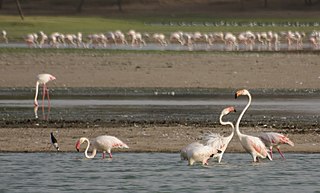
Thol Lake is an artificial lake near Thol village in Kadi in Mehsana District in the Indian state of Gujarat. It was constructed as an irrigation tank in 1912. It is a fresh water lake surrounded by marshes. It was declared the Thol Bird Sanctuary in 1988; it is a habitat to 150 species of birds, about 60% are waterbirds. Many migratory birds nest and breed in the lake and its periphery. The two most prominent species of birds recorded in the sanctuary are flamingoes and sarus crane. The sanctuary is also proposed to be declared an Eco-Sensitive Zone, conforming to the Environment (Protection) Act, 1986, for which draft notification has been prepared.
The Chhilchhila Wildlife Sanctuary, also known as Seonthi Reserve Forest, is located near Kurukshetra University in Kurukshetra district in the Indian state of Haryana. Baba Rodanath Dera temple is on the periphery of the Chhilchhila Sanctuary.

The Jatayu and Sparrow Conservation Breeding Centre (JCBC), is the world's largest facility for the breeding and conservation of Indian vultures and the house sparrow. It is located within the Bir Shikargah Wildlife Sanctuary in the town of Pinjore in the State of Haryana, India. It is run by the Haryana Forests Department and Bombay Natural History Society with the help of British nature conservation charity Royal Society for the Protection of Birds. It is 8 kilometres (5.0 mi) from Pinjore and covers 5 acres (2.0 ha).

Sajjangarh Biological Park is a zoological garden located in Udaipur, Rajasthan, India. This biological park is situated just beneath the Monsoon Palace, around 4 km from the city center.
The wildlife of Bahrain is the flora and fauna of the archipelago of Bahrain, and is more varied than might be expected of this small group of islands in the Persian Gulf. Apart from a strip of the north and west of the main island, where crops such as potatoes are grown with irrigation, the land is arid. With a very hot dry summer, a mild winter, and brackish groundwater, the plants need adaptations in order to survive. Nevertheless, 196 species of higher plant have been recorded here, as well as about seventeen species of terrestrial mammals, many birds and reptiles, and many migratory birds visit the islands in autumn and spring.

Todgarh Raoli Wildlife Sanctuary is a wildlife sanctuary in Rajasthan, India. Spread over the Ajmer, Pali and Rajsamand districts of the state, it was established in 1983. It occupies about 495 km2 of tropical deciduous forests and grassland. Major wildlife includes leopard, wild boar, chinkara, common langur, sloth bears and Indian wolf. Also, about 143 bird species were recorded here in the 2013 survey. Nearest major town is Ajmer, which is 105 km away. Ajmer Junction Railway Station and Beawar Railway Station are the nearest railheads.
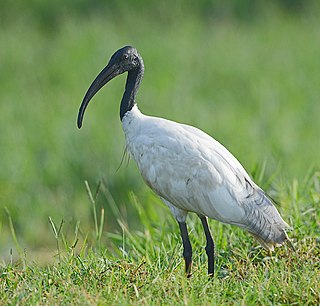
Basai wetland, located in Basai village in Gurgaon tehsil in Gurgaon district in Haryana, India, is a flora and fauna rich water body. It is recognised as one of India's Important Bird and Biodiversity Areas and is of global conservation significance as it supports populations of several endangered, vulnerable, and threatened bird species. Basai wetlandis recognised globally as an Important Bird Area (IBA) by the BirdLife International housing 20,000 birds of over 280 species including migratory birds and endangered birds, has not yet been declared a protected wetland by the Government of Haryana.
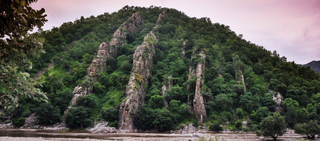
Phulwari ki Nal Wildlife Sanctuary is in Udaipur District of Rajasthan, in the southern Aravalli Hills bordering the state of Gujarat, India. It was declared a Wildlife Sanctuary on 6 October 1983 by the Government of Rajasthan.



















